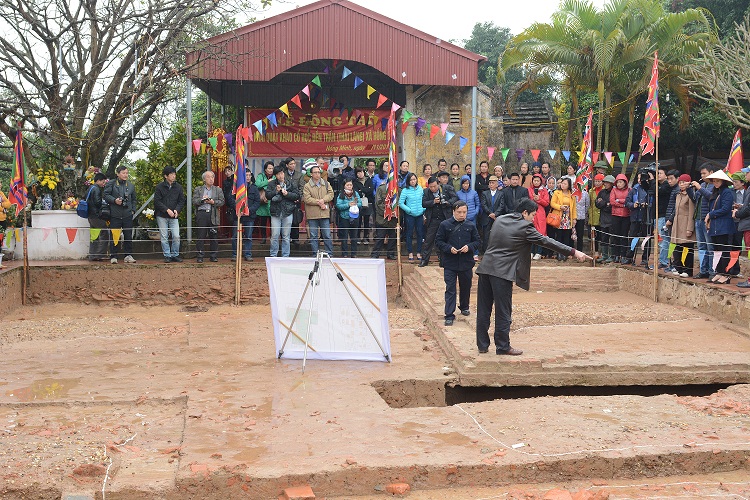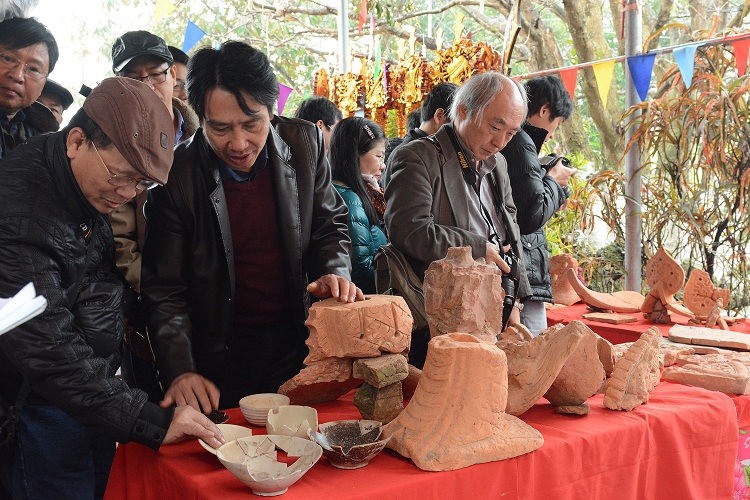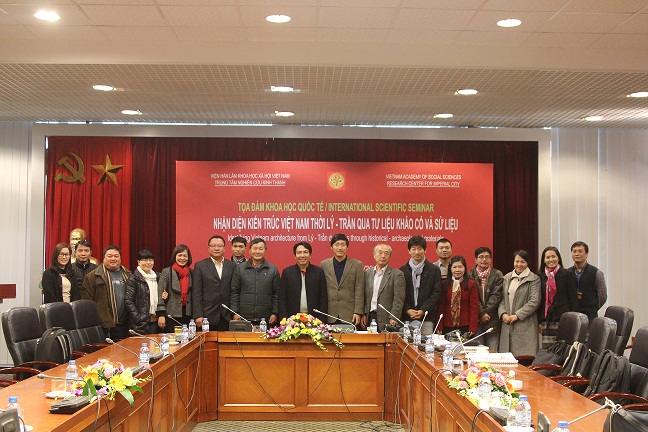Attending in the seminar has Prof. Dr. Nguyen Quang Thuan - Vice President of VASS with Japanese scientists as Dr. Tomoda Masahiko - Team leader, National Research Institute for Cultural Properties, Tokyo; Assoc. Prof. Dr. Ota Shoichi - Cultural Heritage Education Research Center, Kyoto Institute of Technology, Prof.Dr. Shimizu Shinichi - Tokushima Bunri University as well as Assoc. Prof. Dr. Bui Minh Tri - Director of RCIC, Assoc. Prof. Dr. Lai Van Toi - Deputy director of RCIC from VASS. There are also many participants from universities, other specialized research institutes and organizations.
Architecture as works created by man and left his mark in every period. They are considered as mirror images for level of sciences, technology, technique, arts as well as distinctive or similar cultural nuances of each country, each nation from this period. Located in the cradle of Asian civilization, similar to ancient architectures from China, Japan, Korea, Vietnam architecture mainly was created by wooden supporting frame (wooden architecture). The remaining wooden building in Vietnam mostly are architectures for religion and belief.
In excavation of 2002 - 2004 and 2008 - 2009, archaeologists found underground of the Thang Long Imperial Citadel Site many vestiges of buildings through foundations and stonebases. These remains were identified as traces of palace architecture, pavillions, surrounding walls and etc, that affirmed special value and importance of research on Thang Long Imperial Citadel Site for many years. Along with architectural remains, the site also found many constructional materials which are decorated sophisticatedly with theocratic and kingship pattern such as dragon, phoenix, reflecting technical level and distinctive nuance of Vietnam palace architecture from Ly - Tran dynasites.
The seminar has 17 research papers appropriated with 04 above topic, divide into 03 sessions and 01 visit to the Lo Giang Palace site (Hong Minh commune, Hung Ha district, Thai Binh province).
Session 1: There are 07 research papers of Dr. Tomoda Masahiko, Assoc. Prof. Dr. Ota Shoichi, Prof. Dr. Shimizu Shinichi, MA. Pham Le Huy (University of Social Sciences & Humanities), Assoc. Prof. Dr. Trinh Sinh (Institute of Archaeoloy), Dr. Trinh Hoang Hiep (Institute of Archaeology) and Mr. Dao Xuan Ngoc (RCIC). These papers presented research results of architectural vestiges, architectural models and constructional materals of Ly - Tran dynasties, in which highlighting the hypothesis of the existence of dougong brackets (*); analysing and comparing the remaining model of ancient houses and architectures in Vietnam; clarifying characteristics of Vietnam ancient architecture and the influence from foreign architectures; describing architectural components and techniques under Ly - Tran dynasties from ancient writings; Champa imprints in Ly period arts & architectures along with presenting initial study of the Buddhist architectures from Ly - Tran dynasties from archaeological materials.
Seminar overview
ession 2: MA. Nguyen Van Anh and Dr. Dang Hong Son from University of Social Sciences & Humanities; Dr. Ngo Thi Lan from Institute of Archaeology presented research results of types, techniques, functions of roof-tiles and roof-decorations under Ly-Tran dynasties; bricks, tiles and decorations from Tran-Ho dynasties in Tay Do area; continuous and developed imprints in traditional production of bricks, tiles from Tran-Ho dynasties to Le dynasty.
Seminar overview
After two first session, delegates and scientists have visited the Lo Giang Palace site (Tran dynasty), where was excavated by RCIC in 2014 and 2015. Assoc.Prof.Dr. Bui Minh Tri has introduced the initial results of excavations of architectural remains of Lo Giang Palace Site (Kien Xuong Palace) under King Tran Hien Tong, Tran Anh Tong and discussed with other scientists about architectural forms from archaeological traces.
 |
|
|
|
 |
Session 3: Based on materials and research results of Ly-Tran dynasties from presentations and field trip, the seminar continued with presentations of Assoc.Prof.Dr. Nguyen Thi Phuong Chi (Institute of History), Mr. Le Dinh Ngoc (RCIC), Dr. Nguyen Hong Kien (Institute of Archaeology), Assoc.Prof.Dr. Bui Minh Tri. Scientists excitedly discussed about Lo Giang Palace and general awareness of Vietnam architectural form under Ly dynasty from the light of archeaology. Simultaneously, this session focused on analysing Ly period architecture with supporting frame as “dogoung system” which be similar to wooden architecture of palaces in China, Japan and Korea. However, in Vietnam, they were more simple and combined with some traditional architectural characteristics.
The seminar took place successfully. The opinions from delegates and scientists will be precious resources to make the first step for a long journey of the study of Vietnam architecture in general and the Ly - Tran dynasties in particular.
 |
On behalf of leadership of VASS, in the opening remark, Prof. Dr. Nguyen Quang Thuan emphasized that the important objective is to continue to conduct comparative research, do classifications and evaluation of value of vestiges, artifacts from this heritage area. It is order to serve for assesing completely the scientific value of each vestiges and objects of the Thang Long Imperial Citadel as well as to build up system of scientific documents, which play an important role for promotion, propaganda along with conservation planning and value promotion of the heritage area. Besides that he highly appreciates RCIC’s efforts in copporation with domestic and foreign scientists to increase comparative research, in which, concentrate into investigation, excavation and collecting materials to build up database for basic study as well as study and analyse the value of vestiges, artifacts. Prof. Dr. Nguyen Quang Thuan affirmed that to identify and recognize Vietnam architecture from Ly - Tran dynasty through ancient Vietnam architectural models combined with comparative researchs on domestic and foreign architectures was a new approach. The results of this program indicated the effective cooporation between RCIC and Japanese experts during 5 years (from 2011-2015), that is a significant present to celebrate five-year anniversary of RCIC’s establishment.
In keynote speech, Assoc. Prof. Dr. Bui Minh Tri outlined some features of ancient architecture in Vietnam in general and Ly - Tran period architectures (wooden architecture) in particular. He also emphasized that purposes of this seminar was aimed to announce some new results of study of ancient Vietnam architecture from Ly - Tran dynasties based on architectural models and other results from many aspects, concentrating into 04 topics: (1) New results of Vietnam architectural forms & relationship with Asian arhictectures; (2) New results of constructional materials on types and fucntions; (3) New results of archaeological excavations, archaeological and historical research on Ly - Tran palace architectures, including palace and religious architectures as well as their relationship with Champa arts; (4) New results of formation of Ly period architecture in the light of archaeology. Contents of presentations concentrated in achievements of research results of ancient Vietnam architectures under Ly - Tran dynasties from many aspects and approaches based on archaeological and historical materials.
Nguyễn Thu Trang







